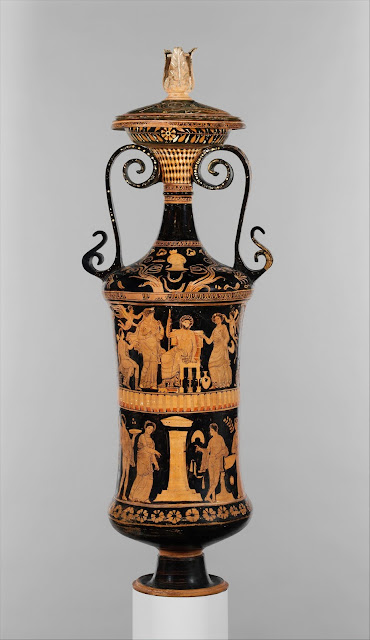Terracotta loutrophoros (ceremonial funeral vase for water), Tarentine, 340–330 BCE, attributed to the Darius Painter, Apulian, south Italy
The Tarentine predilection for disciplined yet exuberant embellishment is applied here to an imposing vase with deeply serious iconography. In the primary scene, Persephone and Aphrodite, who both laid claim to the beautiful hunter Adonis, await a judgment from the deity seated between them. He may be interpreted as Zeus or as Hades, ruler of the Underworld. Differing versions of the verdict allowed the hero to divide his time between the goddesses. In the zone below, a youth is isolated between a grave monument and a laver as figures approach from either side. The themes of death and the Underworld are complemented with luxuriant vegetation. The myth of the death and rebirth of Adonis is connected with seasonal change, and the abundant vegetation on this loutrophoros could symbolize rebirth, an appropriate theme for a funeral vase. - Metropolitan Museum of Art
Apulian vase painting was the leading South Italian vase painting tradition between 430 and 300 BCE. Of the approximately 20,000 surviving specimens of Italian red-figure vases, about half are from Apulian production, while the rest are from the four other centers of production, Paestum, Campania, Lucania and Sicily. The south Italian clays are less rich in iron than Attic clay. As a result, south Italian clay would not reach the rich red known from Attic red-figure vases. This was compensated for, however, by the addition of slips of light ochre clay before firing, which also produced smoother surfaces. Ancient Tarantino, which became Tarentum under the Romans, was the main production center for Apulian vases and produced two styles - the "Plain" and the "Ornate."
The "Plain" style was mostly used for the decoration of bell kraters, colonet kraters and smaller vessels and used little supplemental coloring. Pictorial compositions usually included one to four figures (e.g., works by Sisyphus Painter, Tarporley Painter). The motifs focused on mythical subjects, but also included women's heads, warriors in scenes of battle or departure, and Dionysiac retinue imagery.
The "Ornate" style, as exemplified here, was used on larger vessels such as volute kraters, amphorae, loutrophoroi and hydriai. Compositions contained up to 20 figures, often arranged in two or more registers. The figures frequently appear to be floating. Supplemental coloring was used copiously, especially red, gold/yellow and white. While ornamentation had originally been relatively simple, from the mid-fourth century BCE onwards, painters increasingly placed rich vegetal ornaments, especially on the necks and sides of vases. At the same time, simple perspective depictions of architecture, especially of "Underworld Palaces" (naiskoi) became common. From about 360 BCE, a common motif was grave scenes showing individuals performing offerings at a stylized grave or pillar. Important representatives painters include the Ilioupersis Painter, the Darius Painter and the Baltimore Painter.
Popular mythological motifs include the Assembly of the Gods, the Amazonomachy, Bellerophon, Heracles, and events of the Trojan War. There are also many individual depictions of myths that are not commonly depicted elsewhere. In the second half of the fourth century, depictions of weddings, women and erotic motifs become more common. Apulian vases also occasionally depict theatrical scenes, which are also known from the other South Italian traditions, but absent in Attica. These include motifs from dramatic theatre as well as farce (phlyax play). In contrast, scenes of everyday life and athletic motifs disappear from the repertoire almost entirely after 370 BCE.
Image: Terracotta loutrophoros (ceremonial funeral vase for water), Tarentine, ca. 340–330 BCE, attributed to the Darius Painter, Apulian, south Italy, courtesy of the Metropolitan Museum of Art.




Comments
Post a Comment